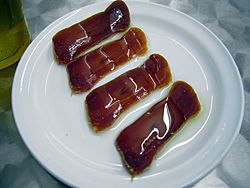Mojama facts for kids

Mojama
|
|
| Course | Appetiser |
|---|---|
| Place of origin | Spain, Italy |
| Region or state | Valencia, Andalusia, Region of Murcia, Liguria, Sicily, Sardinia |
| Serving temperature | Cold |
| Main ingredients | Tuna |
Mojama is a special food from countries around the Mediterranean Sea, like Spain and Italy. It's made from tuna fish that has been salted and dried. Think of it like a type of cured meat, but it's fish! It's very popular in places like Huelva and Cádiz in Spain.
What Does "Mojama" Mean?
The word mojama comes from the Arabic word musama, which means "dry." But the idea of drying tuna goes back even further to the Phoenicians. They were an ancient people who lived a long time ago. They learned how to dry tuna using sea salt. This helped them keep the fish fresh for a long time. They could then trade it with other people. One of their first settlements was called Gdr, which is now the city of Cádiz.
How Is Mojama Made?
Making Mojama is a careful process. First, people use the long, meaty parts of the tuna fish, called the loins. These loins are covered in salt for about two days. This process is called curing. The salt helps to remove water from the fish.
After two days, the salt is washed off the tuna loins. Then, the fish is hung up to dry. It dries in the sun and the breeze. This traditional drying process takes about fifteen to twenty days. This slow drying gives Mojama its special taste and texture.
How to Eat Mojama
Mojama is usually served in very thin slices. People often drizzle a little olive oil over it. Sometimes, they add chopped tomatoes or almonds for extra flavor.
In Madrid, the capital of Spain, Mojama is a popular snack in the afternoon. It's often served as a "tapa," which is a small dish of food. People enjoy it with olives. It's a tasty way to enjoy a piece of Spanish culture!
See also
 In Spanish: Mojama para niños
In Spanish: Mojama para niños

